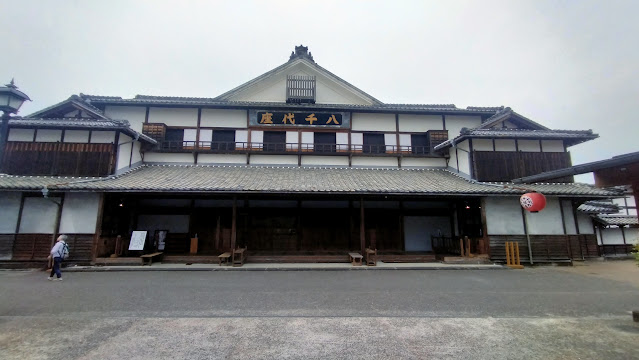美味しい朝食を頂き、お世話になったご夫妻にお別れ。有難うございました!
最初に見学した建造物はきくち城と名づけられているが、むしろのろしなどの伝達の塔だったらしい6-7世紀ごろの建物。一見、中国的な三重の塔の様に見える。
バランスの取れた美しい建物だ。二つ目は八千代座という1910年に建てられ、今日まで劇場として使われている建物。
つい先日玉三郎さんも公演、海老蔵さんも公演が予定されている、という生きている劇場だが、昔の雰囲気が丁寧に残され、味がある。楽屋や仕掛けのある地下も見学させてもらえ、実に面白い。
ワルターが昨日(阿蘇で?)足をくじいたのか、びっこをひき始めたのでドラッグストアでシップを買い求める。別府について温泉地獄を見るも、足を引きずって歩くのが痛々しいので、早々にホテルに入る。
昨年塩の道120kmを歩いた時も、最後私は元気で、ワルターがグロッキーだったのを思い出す。今も似たような状況ですねえ・・・。
We say goodbye to Koba-san and visit a watchtower, the original of which was built here 1,300 years ago. It is a kind of "reporting centre" from which smoke signals are said to have been passed on to other towers. As Kyushu was the part of the country closest to China and Korea, people were already worried that attacks on Kyushu would be launched from there.
We continue to an old (1910) kabuki theatre, which was restored a few years ago. You can feel the atmosphere that prevailed among the maximum 650 spectators. Even today, the best kabuki actors come here to perform on a "real" stage. Numerous advertising posters hang from the ceiling.
The stage can be rotated from underground. In two places, actors can be lifted onto the stage "from the underground". Out of nowhere, so to speak. A friendly woman explains the eventful history of the theatre in detail.
After Kabuki was no longer so attractive, the building became a cinema. As cinema-goers slowly but surely declined, the theatre fell into disrepair and was only restored to its original state a few years ago.
Of course, we also take a look at the "underground" from which the actors could be lifted onto the stage. It only took four - probably strong men - to turn the 10 metre (diameter) stage. The mechanism is labelled "KRUPP" in large letters.
So they not only built cannons, but also revolving stages in Japan.
In the afternoon we reach Beppu, a city from which hot steam rises even from the sewers. Clouds of smoke can be seen over the whole city. We only visit two of the 10 hot springs that are open to the public. The fun is not cheap: 500 yen to look at bubbling mud.
Tourists come here in droves, mainly Chinese. They can be recognised everywhere by the fact that they walk around with long "selphie sticks".
We move into a traditional Japanese room in a somewhat run-down hotel right next to the main road.















